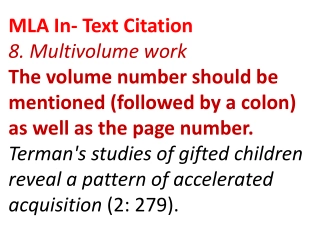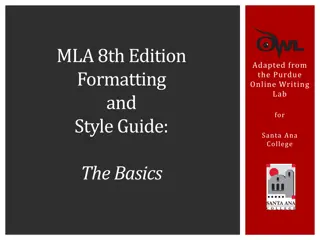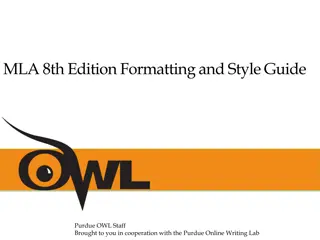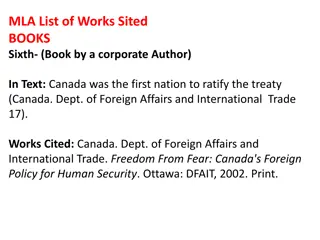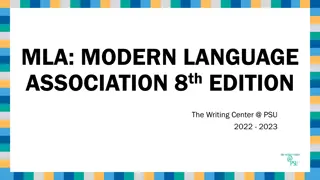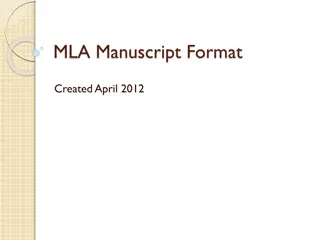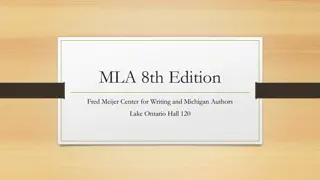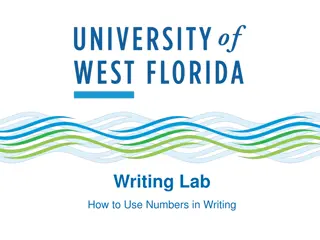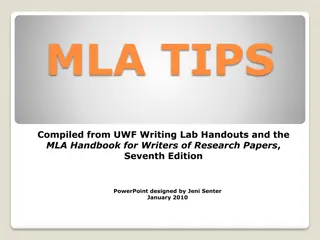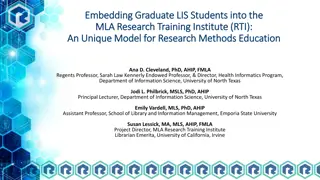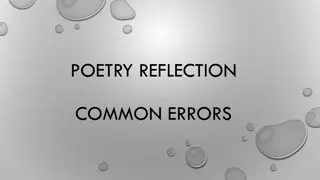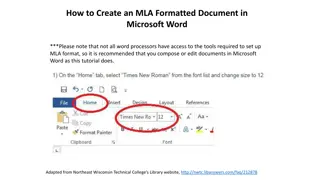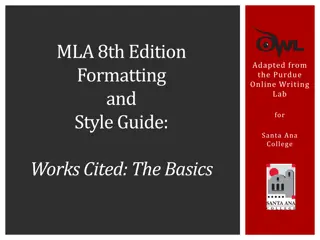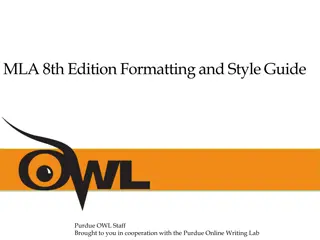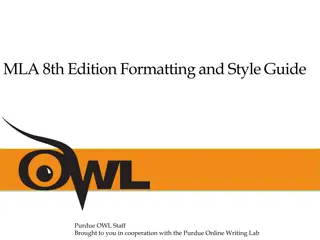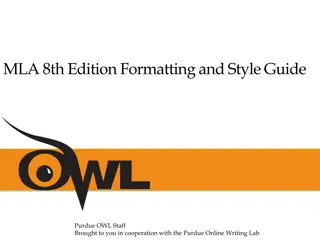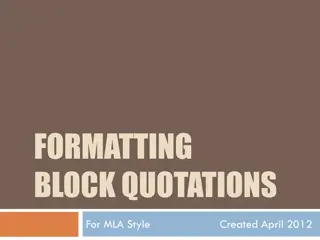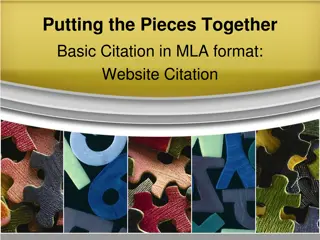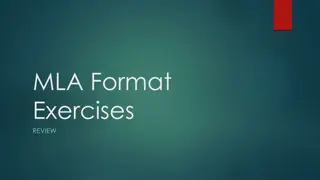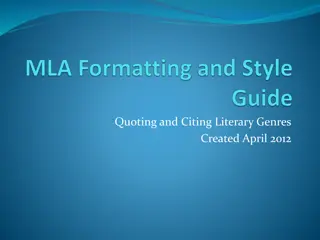Mastering MLA Style: A Comprehensive Guide
The presentation by the ISU Writing Center covers the essentials of MLA style, including what MLA is, how to format papers, create in-text citations and Works Cited pages. It explains the overview of MLA style, why it is used, and the general rules to follow. Detailed information on creating headers, identification details, and an example paper in MLA format are also provided. Master the art of using MLA style effectively with this informative guide.
Download Presentation

Please find below an Image/Link to download the presentation.
The content on the website is provided AS IS for your information and personal use only. It may not be sold, licensed, or shared on other websites without obtaining consent from the author.If you encounter any issues during the download, it is possible that the publisher has removed the file from their server.
You are allowed to download the files provided on this website for personal or commercial use, subject to the condition that they are used lawfully. All files are the property of their respective owners.
The content on the website is provided AS IS for your information and personal use only. It may not be sold, licensed, or shared on other websites without obtaining consent from the author.
E N D
Presentation Transcript
The ISU Writing Center Presents:
What this presentation will cover What MLA is, who uses it, and why How to format a paper in MLA How to format an MLA in-text citation How to create a Works Cited page
MLA style overview MLA stands for Modern Languages Association It is used most heavily in the humanities, so you may see it in English, Linguistics, and Cultural Studies. Humanities journals usually require MLA style.
Why use MLA style? Like all citation styles, MLA standardizes writing so that articles and journals are consistent. To avoid plagiarism, MLA sets standards for how to give credit to your sources to allow the reader to easily determine when/where you used sources, and to allow others to find the sources you used.
General MLA Rules -12-point font -Double spaced the whole way through -Use a legible, attractive font like Times New Roman. Be sure the italics version of your font contrasts enough to draw emphasis -Set margins to 1 inch all around -The start of each paragraph is indented
Header 3 4 5 2 1 Click on the Page Number drop-down menu. Open the header by double clicking at the top of the page. Select Top of Page, Plain Number 3, which should put a page number in the top right corner of the page. Type your last name next to the page number and then a space. Make sure you change your header font.
Identification Information in MLA MLA does not use a cover page, so your identification information will go at the top of your first page of text. Placement: upper left-hand corner of the first page. Like everything else, it is double-spaced. Information: your name, the professor s name, the course name, and the due date.
Example Student 1 Greta Student Dr. Professor English 220 13 November 2023 A Centered Title Paper begins here with no extra space between the title and the start of the text.
In-Text Citations In-text citations are used any time you use another person s words or ideas. They allow the reader determine exactly which thoughts and words are yours, and which came from elsewhere. They match up with the citations on your works cited page. Even if you don t use the exact words from the source, you must cite the ideas and information.
Information included In-text citations for MLA include the author s last name, as well as the page number (or page range) on which the quote or idea was found. If there is no author name, use part of the title of the source to allow your reader to match your quote to your works cited page. If no page numbers are given, you will not include this information. Multiple authors change your citation.
2 Formats for In-Text Citations The author s name can be used to introduce the quote, or it can be included in the parenthetical citation. Faye Mallow explains that dolphins sleep with one half of the brain at a time (12). Most people don t realize that dolphins sleep with one half of the brain at a time (Mallow 12).
Remember that your citation will be the same whether you directly quote or paraphrase. Keep in mind that you don t want to hold your citations until the end of your paragraph. Use the citation directly after you finish quoting or paraphrasing.
Can You Format These? #1 Source information: Author- Faye Mallow Title- The Mind of a Dolphin Publication year- 2019 Pages- 14-17 Quote- dolphin language is complex In Text: After text:
The Works Cited Sometimes called References or Bibliography in other styles, the Works Cited offers full citation information for your sources. This allows your reader to find the same information you found. The full citations should be easily matched to the in-text citations found throughout your paper.
Formatting the Works Cited The words Works Cited appear at the top of the page in normal font. The Works Cited should appear on a separate sheet of paper at the end of your essay. This page is still numbered and double-spaced throughout (including citations). MLA makes use of a hanging indent. The page is arranged alphabetically by author s last name.
Information to Include in Citations Every type of source is cited in a different way. Consult the MLA guide or The Owl at Purdue for specifics. In general, you should include the following information: Print sources: author s name -title of article -title of journal - volume/issue/edition -publisher - year of publication -pages -editors/translators - Electronic sources: Author or organization -title -website title - journal name -publication date -database - -version/issue numbers - DOI -URL -access date -pages -
Examples of Citations A Book Hill, Candice. Images of Autumn in the Poems of Emily Dickinson. Harvard UP, 2010. A Journal Article from a Database Scott, Donald. The Dictionary War. The College English Association Review vol. 11, no. 3, 4 Nov. 2021, pp. 80-98. Jstor, https://doi.org/10.1002. Accessed 14 Nov. 2023. A Page on a Website Smith, Robin. Poe s Favorite Pub. Poe Society Online, www.poesociety.org
Time To Try It! The information below belongs to a journal article from an online database. Can we figure out how to cite it? Article Title: The Harlem Renaissance Through Literature Year: 2016 Journal: The Literary Studies Journal Database: JStor Access Date: November 12, 2022 URL: https://www.doi.10.02341dc Author: Elaine Marlow Page range: 12-25
Remember: IT S ALMOST IMPOSSIBLE TO MEMORIZE EVERY SINGLE TYPE OF CITATION, AND THE RULES DO CHANGE FROM TIME TO TIME. YOU SHOULD BECOME FAMILIAR WITH THE RESOURCES THAT EXIST TO HELP YOU LIKE THE MLA HANDBOOK AND THE PURDUE OWL. AND COME SEE US AT THE WRITING CENTER! WWW.INDSTATE.MYWCONLINE.COM


